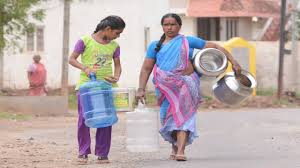In Maharashtra, a panchayat with its own revenue channels awaits water flow from Jal Jeevan taps

A gram panchayat in Maharashtra, despite generating its own revenue, still waits for piped water under the Jal Jeevan Mission. This delay highlights the gap between policy promises and on-ground delivery. The village manages its finances well, collects local taxes, and runs community services — yet taps installed under the scheme remain dry.
Financially Strong, Yet Facing Water Scarcity
The village, located in Marathwada, regularly faces water shortages. It operates with financial independence, collecting house taxes and leasing community assets like halls and shops. These funds help maintain basic services, including lighting, roads, and local infrastructure.
But clean drinking water remains out of reach. Women and children still depend on borewells or tanker supplies, especially during summer. Despite readiness and local efforts, the village hasn’t received regular tap water.
The Jal Jeevan Mission’s Delayed Promise
The government launched the Jal Jeevan Mission (JJM) in 2019. Its goal was to provide functional tap water connections to every rural household by 2024. Panchayats play a key role in planning and executing the scheme.
This village followed all guidelines. It set up a Village Water and Sanitation Committee (VWSC), prepared a water security plan, and allocated funds for maintenance. But the water pipeline project has stalled.
A panchayat member said, “We completed all the paperwork and cooperated with officials. The contractor began work but left it incomplete. The pipeline ends outside the village and hasn’t been connected to homes.”
Delays Due to Poor Execution and Oversight
Many rural areas in Maharashtra face similar issues. Contractors often delay work or leave it incomplete. State and central agencies don’t always coordinate well, which affects timely project delivery.
A Pune-based expert explained, “Local bodies are ready and capable. But the over-reliance on contractors slows things down. When a panchayat is active and well-funded, it should be given more authority.”
Several panchayats in the state face challenges like delayed tenders, lack of engineers, or irregular fund releases. These issues slow down even the most prepared villages.
Women and Children Bear the Brunt
The burden falls heavily on rural women and children. In this village, young girls and mothers spend two to three hours each day fetching water. Some students even skip school due to water shortages on campus.
“We received promises in early 2023 that the taps would be working soon. Now it’s mid-2025, and nothing has changed,” said a mother of three.
The village has tap installations, but they don’t deliver water. The frustration continues to grow, especially among women who shoulder most of the responsibility.
Why Reward Self-Reliant Panchayats with Neglect?
This panchayat generates over ₹10 lakh in annual revenue. The funds support daily operations and development work. But when it comes to water, it depends on slow-moving government departments.
The sarpanch said, “We maintain roads and pay for sanitation from our own income. Yet, we can’t get access to a basic water line. We’ve even offered to co-fund the work. Still, we’ve seen no progress.”
Local leaders believe the system penalizes efficient panchayats. Instead of encouraging independent development, bureaucratic red tape holds them back.
Panchayat Seeks Control Over Implementation
The village has requested permission to manage the remaining pipeline work. Leaders believe that direct control will speed up the project and bring better accountability.
Experts support this idea. “Empowering villages with technical and financial control works well in capable areas,” said a Mumbai-based policy analyst. “We need to trust gram panchayats more.”
Giving villages the power to manage their water systems can reduce delays. It also builds local ownership and ensures better maintenance in the long term.
Official Acknowledgment and a Hopeful Outlook
An official from the Public Health Engineering Department admitted the delay. He said logistical issues and labor shortages during the pandemic affected the project timeline.
“We plan to restart work in the next quarter. The panchayat’s role is strong, and we’re considering ways to let them manage some of the execution,” he added.
Meanwhile, the village is working on short-term solutions. They are repairing old wells and installing community-level filters. These measures help, but they aren’t enough to meet daily needs.
Conclusion
This case reveals a deeper challenge in India’s rural development programs. Even proactive and self-sufficient villages suffer due to rigid systems and slow execution.
The Jal Jeevan Mission has noble goals. But without flexibility and trust in local governance, its impact remains uneven. For this Maharashtra panchayat, the taps are ready — now all they need is the water to flow.






